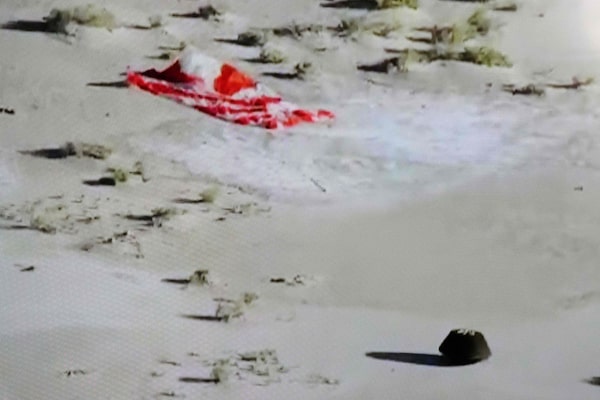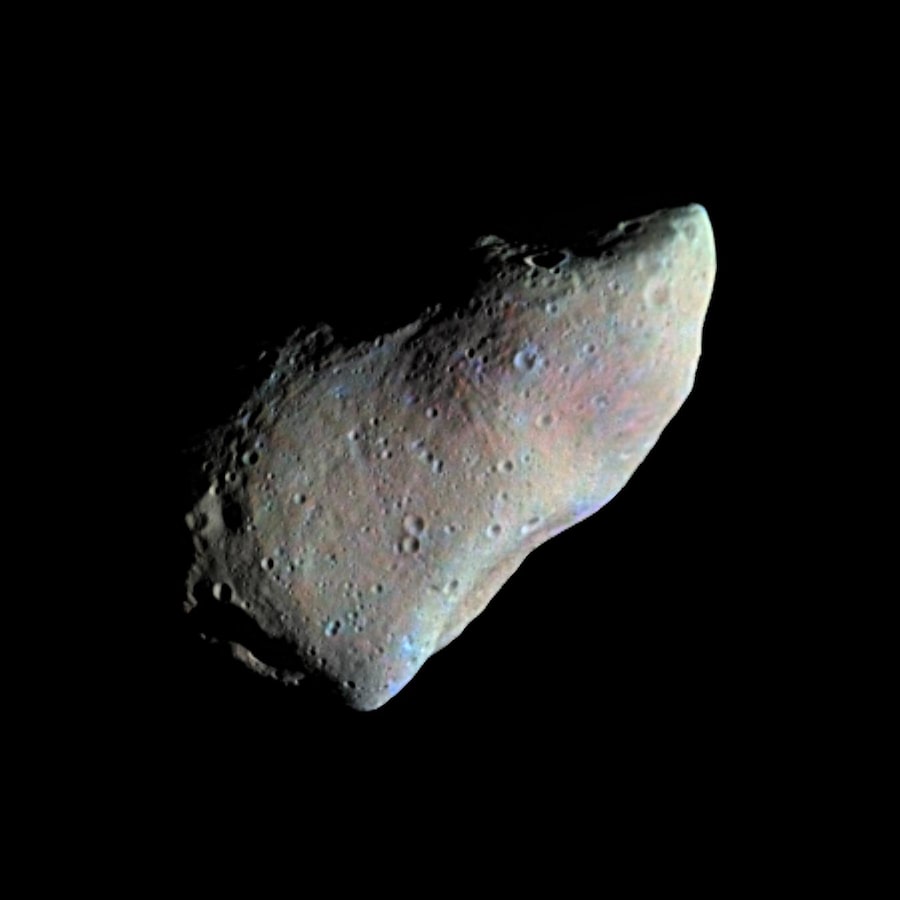
This shot off a NASA live feed of the OSIRIS-Rex asteroid sample's return craft sitting in the Utah desert at Dugway, Utah, on Sept. 24.HANDOUT/AFP/Getty Images
For an asteroid named after an Egyptian deity associated with sunrise and rebirth, it was a fitting entrance.
On Sunday morning, a piece of Bennu (the asteroid, not the ancient deity) appeared in the skies over the Utah Test and Training Range, aboard a fiery human-made meteor that blossomed into a parachute-borne capsule drifting Earthward after seven years in space.
The capsule’s touchdown at 8:52 a.m. local time marked the dramatic culmination of NASA’s effort to bring home its first extraterrestrial sample from beyond the moon.
With the sample’s return, the OSIRIS-REx mission is expected to shed new light on the nature and history of the solar system’s oldest building blocks.
For scientists involved in the effort, including Canadians who will participate in analyzing the asteroid sample, the capsule’s safe arrival brought relief and elation.
“It’s hard to express how important it is,” said Daniel Glavin, a senior scientist with NASA’s Goddard Space Flight Center and OSIRIS-REx team member. “For me, it’s just much bigger than this project. This is really for humanity.”
The arrival sequence began approximately four hours before the landing, when the OSIRIS-REx spacecraft received an all-clear from flight controllers to release the capsule.
The capsule then sped to Earth, quickly covering the final 100,000 kilometres of its journey while the main spacecraft fired its thrusters to change course, setting itself up for an extended mission that could see it rendezvous with the asteroid Apophis in six years’ time.
Soon after it entered the atmosphere at 12 kilometres a second, the capsule’s exterior became a brilliant fireball easily spotted by high-altitude aircraft watching for its arrival.
The most nerve-racking moments during the landing came about five minutes before touchdown as team members waited for the capsule’s main parachute to deploy and slow down its descent.
Once the chute was sighted, “that was the moment I knew we made it home,” said Dante Lauretta, the mission’s principal investigator and a planetary scientist at the University of Arizona. “After that it was overwhelming relief, gratitude, pride, awe.”
Nineteen years ago, a failed parachute proved disastrous for NASA’s Genesis mission, which crashed into the Utah desert, breaching its sealed container of solar wind particles. OSIRIS-REx avoided that fate, though engineers said they could not yet rule out a glitch with the spacecraft’s initial “drogue” chute, which should have preceded the main parachute but was not observed. More data from airborne cameras may shed light on what happened, they said.
Well before the capsule’s arrival, helicopters were dispatched to prepare for its recovery on the ground. Among the first tasks for the recovery team: checking the area around the capsule for unexploded ordnance, a feature of this isolated and active military site about 130 kilometres west of Salt Lake City that doubles as a catcher’s mitt for NASA’s sample-return missions.
After initial checks, the capsule was airlifted to a temporary clean room and a “nitrogen purge” to keep it in a chemically benign, oxygen-free environment.
The next stop for the capsule is NASA’s Johnson Space Center in Houston, where an initial examination of its contents is scheduled to commence on Tuesday. In the coming days, scientists will learn the quantity of samples that OSIRIS-REx managed to capture when it “tagged” Bennu and made fleeting contact with the asteroid three years ago. A preliminary estimate ranges from 150 to 350 grams.
One possible wrinkle: The analysis could be interrupted by a U.S. government shutdown later this week, though officials said such a delay would pose no risk to the asteroid material retrieved from Bennu.
“This sample’s waited for more than four billion years for humans to study it,” Lori Glaze, director of NASA’s planetary science division, said during a press briefing prior to the capsule’s arrival. “If it takes us a little longer, I think we’ll be okay.”
The fact that Canadians will be among the first to do the studying, and that Canada will eventually take possession of a 4-per-cent share of the sample, can be credited in part to Marc Garneau, the Canadian astronaut and later cabinet minister who served as president of the Canadian Space Agency from 2001 to 2005.
During his tenure, Mr. Garneau was a strong advocate for Canada’s involvement in Mars exploration. The support led to a Canadian laser system being selected as an instrument for NASA’s Mars Phoenix mission, which landed on the red planet in 2008. That success later put Canada in line to build a laser ranging system for NASA’s first sample-return mission from an asteroid.
“You sometimes have to show you can do it and then other opportunities open up,” said Mike Daly, a professor at York University in Toronto and Canada’s principal investigator for OSIRIS-REx, who was in Utah for the capsule’s arrival.
Along the way, engineers had plenty to learn about how to turn a stationary laser system on Mars into one that could work on a flying probe attempting to map a complex and moving target.
“We had to understand the timing very precisely,” said Cameron Dickinson, a planetary scientist and technical lead with MDA, the Brampton, Ont.-based aerospace company that built the OSIRIS-REx Laser Altimeter, or OLA. The instrument was ultimately used at Bennu to map the asteroid and help guide the search for a sample collection site.
Now the careful and deliberate task of assessing that sample can begin. Canadian Space Agency representatives will be on hand in Houston to get an initial sense of how much material they will eventually have to work with, and how to make the most of Canada’s national allotment.
“It’s trying to understand the start of the solar system,” said Caroline-Emmanuelle Morisset, a program scientist with the CSA. “You’re trying to analyze everything that you can, that can help you identify what was the composition in that window of time.”
What the analysis will show is likely to take years to fully appreciate, said Dr. Daly, who will be among the first to receive a portion of the sample in Canada to test the asteroid’s thermal properties. But it is certain to yield something new, he added.
“Bennu surprised us when we got there. Bennu surprised us when we tagged. Bennu will surprise us with the return sample,” Dr. Daly said.

Capsule’s return to Earth
The SRC separates from the main spacecraft four hours before arrival. Protected by its heat shield it enters the atmosphere at high speed, then deploys parachutes to slow its descent to a site in Utah. The SRC will then be transported by helicopter to a nearby clean room, and the canister sent to NASA’s Johnson Space Center in Houston, Tex.
SRC hits
atmosphere
at 45,000 km/h
Drogue
chute
released
Main chute deploys at 1,500 m above surface
Drogue chute
deploys at 31,000 m
above the surface
Estimated speed at touchdown 17 km/h
ivan semeniuk and john sopinski/the globe and mail, Sources:
graphic news; NASA Goddard Space Flight Center; University of
Arizona; afp

OSIRIS-REx: Return from Bennu
After a seven-year journey, NASA’s OSIRIS-REx mission is returning to Earth with a sample of a small asteroid called Bennu. Canada’s partnership in the mission means that a portion of the sample will be examined in Canadian labs for clues
to the nature of asteroids and the early history of our solar system.
Mission Timeline:
Launched: Sept. 7, 2016
Arrived at Bennu: Dec. 3, 2018
Collected Sample: Oct. 20, 2020
Departed for Earth: May 10, 2021
Capsule reaches Earth: Sept. 24, 2023
OSIRIS REx: (Origins, Spectral Interp-
retation, Resource Identification,
Security-Regolith Explorer)
Size: 3.15 m
Mass: 880 kg
Bennu asteroid
OSIRIS-REx
Sun
Earth
Solar
array
Heat
shield
Sample head:
Captured asteroid
material during five-
second contact.
Estimated sample
size: About
250 grams
TAGSAM:
Two-metre long
Touch-and-Go sample
arm used pressurized
nitrogen gas to kick up
loose material from the
surface of Bennu
Sample
head
Bennu
Diameter: 510 m
Composed of carbon-rich rock and loose rubble, Bennu is representative of material that was present in the early solar system when Earth formed.
Sample Return Capsule (SRC)
During the return voyage it
protects the sample head and
its contents in a sealed canister.
Capsule’s return to Earth
The SRC separates from the main spacecraft four hours before arrival. Protected by its heat shield it enters the atmosphere at high speed, then deploys parachutes to slow its descent to a site in Utah. The SRC will then be transported by helicopter to a nearby clean room, and the canister sent to NASA’s Johnson Space Center in Houston, Tex.
Drogue
chute
released
SRC hits
atmosphere
at 45,000 km/h
Main chute deploys at 1,500 m above surface
Drogue chute
deploys at 31,000 m
above the surface
Estimated speed at touchdown 17 km/h
ivan semeniuk and john sopinski/the globe and mail, Sources:
graphic news; NASA Goddard Space Flight Center; University of
Arizona; afp Picture: NASA

OSIRIS-REx: Return from Bennu
After a seven-year journey, NASA’s OSIRIS-REx mission is returning to Earth with
a sample of a small asteroid called Bennu. Canada’s partnership in the mission means that a portion of the sample will be examined in Canadian labs for clues
to the nature of asteroids and the early history of our solar system.
Mission Timeline:
Launched: Sept. 7, 2016
Arrived at Bennu: Dec. 3, 2018
Collected Sample: Oct. 20, 2020
Departed for Earth: May 10, 2021
Capsule reaches Earth: Sept. 24, 2023
OSIRIS REx: (Origins, Spectral Interpretation,
Resource Identification,
Security-Regolith Explorer)
Size: 3.15 m
Mass: 880 kg
Bennu asteroid
OSIRIS-REx
Sun
Earth
Solar
array
Heat
shield
Cameras,
spectrometers,
sensors
TAGSAM:
Two-metre long
Touch-and-Go sample
arm used pressurized
nitrogen gas to kick up
loose material from the
surface of Bennu
Sample head:
Captured asteroid
material during five-
second contact.
Estimated sample
size: About 250 grams
Sample
head
Bennu
Diameter: 510 m
Composed of carbon-rich rock and loose rubble, Bennu is representative of material that was present in the early solar system when Earth formed.
Sample Return Capsule (SRC)
During the return voyage it protects
the sample head and its contents in
a sealed canister.
Capsule’s return to Earth
The SRC separates from the main spacecraft four hours before arrival. Protected by its heat shield it enters the atmosphere at high speed, then deploys parachutes to slow its descent to a site in Utah. The SRC will then be transported by helicopter to a nearby clean room, and the canister sent to NASA’s Johnson Space Center in Houston, Tex.
Utah Test and
Training Range
Drogue
chute
released
SRC hits
atmosphere
at 45,000 km/h
Johnson Space Center
Main chute deploys at 1,500 m above surface
Drogue chute
deploys at 31,000 m
above the surface
Estimated speed at touchdown 17 km/h
ivan semeniuk and john sopinski/the globe and mail, Sources: graphic news; NASA Goddard Space
Flight Center; University of Arizona; afp Picture: NASA






 Ivan Semeniuk
Ivan Semeniuk